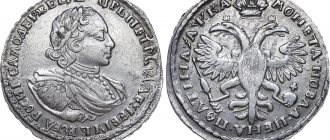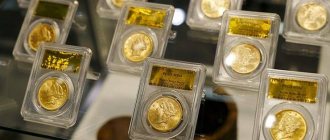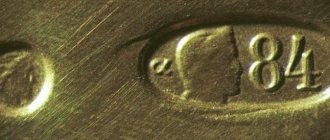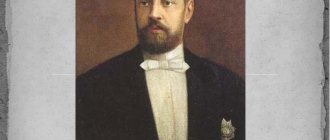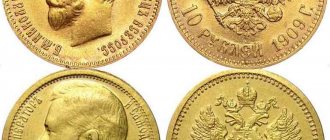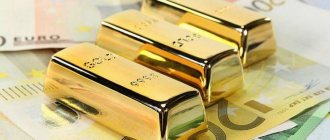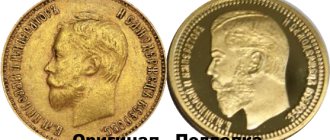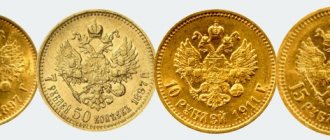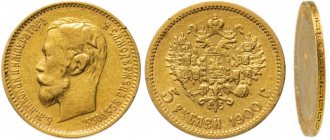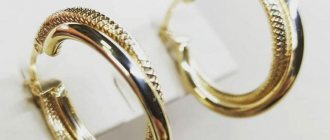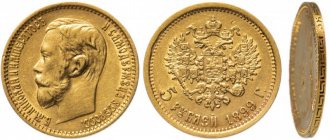Combining data on the most expensive coins in the world is somewhat similar to determining the most attractive of the winners of several beauty contests. Here's how to answer the question "Who is more beautiful: Miss World or Miss Universe?" And why can’t some “Miss South America” who participated in this competition two years earlier be more beautiful than both of them? So it is with the “Most Expensive Coin” nomination. It would seem that you could simply compare the totals of different auctions. But this will not give an exclusively correct answer. After all, the purchasing power of the same American dollar these days is much more modest than in the eighties of the last century. And yet, let’s try to tell in one article about those coins whose value can surprise the imagination.
Hair down
This is the name of the first US $1 silver coin, issued in 1794. It was made by the Philadelphia Mint, the obverse and reverse are the work of engraver Robert Scott. A total of 2,000 coins were minted in 1794, but 242 were immediately destroyed due to poor quality, and the rest were donated to officials. Currently, less than 100 copies have survived. In 1795, another 160,000 coins were minted.
The obverse depicts a woman with flowing hair, symbolizing Freedom. At the top there is the inscription “LIBERTY”, at the bottom – the year “1794”, on the left – 8 stars with six rays, on the right – 7 (at that time there were 15 states).
The center of the reverse of the coin is occupied by a bald eagle, which is the heraldic symbol of the United States. It is surrounded by an olive wreath, around which the inscription “UNITED STATES OF AMERICA” is made along the edge of the coin.
This coin first became a record holder in 2005, when almost $8 million was paid for it. In 2013, a new record was set - the coin was sold for $10 million.
"Double Eagle" by Saint-Gaudens
The famous American sculptor Augustus Saint-Gaudens developed the design of the most beautiful US coin and, at the same time, one of the most expensive, with a face value of $20. Copies of the test coinage appeared in 1907, but technical difficulties immediately arose. The relief of the image was too high, with an abundance of small details and was difficult to stamp. To rectify the situation, the mint's chief engraver, Charles Barber, removed the motto from the reverse: “In God We Trust,” a necessary attribute of all US banknotes. The scandal that broke out in society, and then in Congress, after the appearance of the new circulation, should have led to the seizure of the entire batch, but this did not happen.
“Godless,” as they were called, money was in circulation in 1907–1908. And today, thanks to their rarity, they cost $7.6 million. The copies of the last issue of the mint, which took place in 1933, are valued at the same price. Almost all of them were withdrawn from circulation and melted down after Theodore Roosevelt's decree confiscating gold reserves from commercial companies and the public.
About twenty 1933 Double Eagles were stolen by mint employees for shady jeweler Israel Sweatt. The owner kept the rarities for some time, and then resold some of them to third parties, including the Egyptian King Farouk. Officially, the 1933 Double Eagle is banned and not available for collecting. The last owner of a coin from Farouk's collection, British numismatist Stephen Fenton, donated half of the amount received for it at the Sotheby's auction to the US Treasury. Otherwise, he would face trial and charges of trafficking in valuables stolen from the state.
Description
The Double Eagle revolutionized US coinage, shattering previously existing standards. On the obverse, Saint-Gaudens depicted his own Victory Statue, erected in New York in honor of General William Sherman. A young girl in a Greek chiton symbolizes freedom coming to people. In her right hand she holds a burning torch, which disperses the darkness of ignorance, in her left hand - an olive branch of peace. A girl descends from a cliff in the rays of the rising sun, with the Capitol building to her left in the background. Along the edge the figure is surrounded by stars according to the number of independent states.
On the reverse, the sculptor placed a bald eagle flying against the background of the sun. The design is unique not only in the position of the figures in lively, free movement, but also in the sculptural elaboration that brings them closer to ancient models. As a prototype for his Liberty, Saint-Gaudens chose the statue of the Nike of Samothrace from the island of Rhodes.
Double-headed eagle of Saint-Gaudens
Gold coin with a face value of $20, year of issue - 1933. Its dimensions are modest - a diameter of just over an inch, a weight of a little more than an ounce. The coin is a rarity and a desirable prize for any numismatist. Several pieces were even stolen from the US government treasury, but were later returned.
The minting of such coins began in 1907. In 1928, the stock market collapsed and people began to withdraw their gold deposits. The gold standard was abolished, and only paper equivalents were allowed. The 1933 coins were melted down into bars, but 20 of them survived - it is assumed that they were changed by the cashier.
The obverse of the coin depicts the Statue of Liberty with a traditional torch in her right hand and an olive branch in her left. On the reverse is an eagle with widely spread wings.
The coin was sold at auction for a record price in 2002. The buyer is anonymous; the purchase cost him $7.59 million, and he also paid $20 (the face value of the coin) as compensation to the US government.
Is it profitable to invest in gold coins?
Investing in gold is undoubtedly beneficial in the long run. It is a finite natural resource whose value increases over the years. There are several options for investing in precious metals - physical (gold bars, coins) and non-cash (metal accounts).
Investing in gold money is simple. It is enough to buy them and put them in a secluded place at home or in a bank safe.
Expert opinion
Lyudmila Pestereva
Our most experienced gold investor
Ask a Question
Investment coins have greater liquidity than collectible coins. When purchasing the latter, you will have to pay a value added tax of 18%. To make money on such an investment, you will have to wait more than one decade.
To determine the collectible, antique value, you need to have knowledge in the field of numismatics. Investment gold coins are available to everyone, just like bank bullion.
Advantages and disadvantages
Before deciding to invest in a particular asset, it is important to know about the pros and cons of the transaction. I will tell you about the benefits of investing in gold coins and the possible pitfalls of such an investment.
Expert opinion
Lyudmila Pestereva
Our most experienced gold investor
Ask a Question
The purchase of gold coins is not subject to VAT at the rate of 18%, as are non-cash metal bills. Only in this case you receive your asset in your hands and can freely dispose of it - give it away, sell it. Prices start from 15 thousand rubles. Such an investment is quite accessible to the average buyer.
Gold is continuously rising in price. This is a liquid asset, the price of which will not collapse with the economic crisis. Gold coins are an excellent option for risk diversification if you have the opportunity and desire to invest in different types of assets.
There are also disadvantages:
- This is a long term investment. It takes more than one decade to make money on resale.
- The price per gram of metal is more than in an ingot.
- Storage will require a secure place, possibly a safe, and this is an additional expense.
Brasher Doubloon 1787
This coin was created in 1787 by silversmith Ephraim Brasher. The jeweler asked for permission to mint copper coins, but was refused.
The gold doubloon depicts an eagle surrounded by a wreath, on the chest of which are the master’s initials. In one paw the bird holds an olive branch, in the other an arrow - symbols of peace and readiness to defend freedom. The reverse of the doubloon depicts a mountain from which the sun's rays emanate in different directions. The coin contains almost 1 gram of pure gold.
There are several copies of such a coin, but this one is more valuable because of one difference - the master’s initials are made on the bird’s chest, while on other copies they are minted on the eagle’s wing.
This feature provided the coin with one of the world records - it was sold for $7.4 million.
List of the most expensive coins in the world
As the first step of the pyramid leading to transcendental heights, many sources point to a nineteenth-century Brazilian coin issued in honor of the coronation of Pedro I, who laid the foundation of modern Brazil. Only sixty-four of these coins were minted. The Brazilian emperor appears to us as an ancient Roman, crowned with glory. According to rumors, Pedro the First did not like portraits of this type, but one of them is now immortalized with a circle of gold. One of the batch of these gold pieces was sold at a Chicago auction for one hundred and thirty-eight thousand dollars. What does this tell us? About how relative all these lists of “The most, most expensive...” After all, take a look at our catalog of coins, and almost immediately you will find coins that have gained even more significant amounts at auction. For example, 25 rubles of 1876 , sold at Volmar for 12,599,621 rubles on October 11, 2021. The author who advised not to forget about Brazilian gold could not have known about the auctions that would take place in the future.
On the next step, where real jewelry is collected, there is not only an expensive, but also a very unusual coin. Its face value is 100,000 euros. She was given the affectionate name "Big Phil". The illustration doesn't show how huge it is. So far, "Big Phil" is one of the largest gold coins in the world. It is not by chance that it is called “Phil”, since the coin is dedicated to the Vienna Philharmonic. The treasure, consisting of 1000 ounces of 999.9 fine gold, was released in October 2004 by the Austrian Mint. The diameter of the golden giant is 37 centimeters. And if we convert ounces into our usual measure, we will see a weight of 31.1035 kilograms. The thickness of this rarity is two centimeters, and the circulation is only fifteen copies. When the coins went on sale at a selling price of 330,000 euros, the bins were empty almost instantly. So when the first coin out of these fifteen is put up for auction, even the starting price will already exceed the price at which it was once bought.
Let's take it up a notch. Here we are recommended to pay attention to the golden dinar of Saudi Arabia, which received the name “Dinar Hashimi” and itself gave the name to one of the settlements of this country. It is called the most significant coin of the Arabian Peninsula. This is confirmed by the million-dollar figure achieved at Baldwin Auctions, which specializes in Islamic coins. It is not so easy to understand the Arabic script used for the inscription on the coin field. However, experts say that the dinar was minted in honor of the pilgrimage of Caliph Umar bin Abd al-Aziz.
Brasher's gold doubloon was sold for almost two and a half times more expensive. Its creator is American jeweler Efrem Brasher. At that time in America there was no state monopoly on the issue of coins. But still, minting was trusted to people close to working with precious metals. An experienced jeweler was ideally suited for this purpose. Efrem Brasher worked both on orders and on the production of his own coins from gold and silver. The initials “EB” appeared on the eagle’s wing for a reason. Ephraim Brasher also advocated the issue of a copper coin, but at that time his request did not find positive responses. The glory of the Brasher gold doubloon as one of the most expensive coins was confirmed by another auction, which ended at a fantastic amount: only ten thousand was not enough to reach three million. But there the initials “EV” were already on the eagle’s chest. Although... judging by the database of auction passes, auctions have already taken place that have exceeded this amount.
The rise in the value of rare coins is perfectly illustrated by the 1913 nickel with the head of Lady Liberty, already familiar to us from articles on US coins. Therefore, we will not retell its story here, but recall that in 1972 the auction for it ended at one hundred thousand dollars, and this then seemed an unimaginable amount for a five-cent coin. In 1996, one of the surviving nickels had already reached the million mark. The coin reached three million in 2003, and in 2010 the record was exceeded by another $700,000. The auction owners promise to find a buyer for twenty million, but only for a UNC coin.
“From past to present” can be the title of the next coin. However, ten years have passed since its release. This is where Canada excelled. The country is a member of the British Commonwealth, so it is not surprising to see the profile of Elizabeth II on this coin. The coin is made of pure gold - impurities amount to no more than one thousandth of its weight. However, the weight here is quite remarkable - one centner. At the Dorotheum auction in Austria, the coin changed hands for four times its face value. In addition to being one of the most expensive, at the time of this article’s creation, this coin also bears the title “The Largest Gold Coin in the World.”
We missed it when talking about dollars, but we’ll mention it here. Here is an 1804 First Class Silver Dollar. True, what we see is not an original coin (there are no originals with the date “1804”), but a remake, issued exactly thirty years later. In 2010, his care amount was a beautiful value of $3,737,500. Collectors of Soviet coins will not be surprised, since they know that rare “Khrushchev remakes” are also sold at several times more expensive than original coins of the same condition. From the sources describing this coin, it can be understood that only eight copies were issued that year, which were subsequently supplemented by another seven, minted later. The glory of one of the coins was that it was part of the grandiose collection of the King of Siam. Here it is difficult to judge how legitimate the place of this dollar is in the hierarchy we are compiling, because the amount of 4.14 million dollars was paid for the entire collection when, after the death of the owner, it ended up at auction. You can find pages where such a coin is called the second most expensive. But now she has been knocked out of the top three.
Florin of Edward the Third
The specimen is the first florin made of gold. It weighs 9.96 grams, is made of pure gold, and is valued at 6 shillings. It was minted in 1343. Collectors call this coin the Double Leopard.
The coin does not have clear boundaries, since the edge had not yet begun to be made. The obverse depicts the figure of a king on a throne.
The coin is worth 6.8 million dollars. That's what they paid for it at the Spink auction. The world knows about only 3 such coins.
Price
You can determine how much a gold coin is worth based on its rarity, precious metal content, and demand in the numismatic or investment market. Anyone who has this valuable piece can sell it for a higher price, since over time the value of the most expensive coins will only increase. At the same time, the best gold coins to buy can be any type, because the value of the precious metal is only growing.
Gold Dinar Hashimi
The coin was found in the Middle East. It was minted in 723, presumably for the pilgrimage of Caliph Umar ibn Abd Al-Aziz to Mecca.
The specimen is one of the most significant minted on the Arabian Peninsula and the rarest in the world. All inscriptions on it are made in Arabic.
At London auction in 2011, the lot reached $6 million, and it was originally priced 10 times cheaper. The expensive purchase was made by a private collector from Europe.
How much do investment coins cost in Sberbank of Russia today?
The price per gram of precious metal in investment coins is set depending on the rate set by the Central Bank. He, in turn, is guided by data recorded twice a day on the London Bullion Exchange. Sberbank's assortment includes investment and commemorative gold coins of Russian and foreign origin.
Refunds upon purchase vary depending on condition. The buyback price differs from the sale price by 10-15%.
Freedom in a turban
$10 gold coin. This series was minted between 1795 and 1804, producing more than 132,000 pieces in total, but the mintage includes certain varieties, so some are more valuable.
The obverse of the coin depicts Liberty in a turban, with the inscription “LIBERTY” on top, “1804” on the bottom, 5 on the right, and 8 stars with six rays on the left, according to the number of states at that time.
According to experts, this specimen is worth $5 million.
Classification of gold coins
So, you have already realized that gold alloy banknotes are a good investment option. All that remains is to decide which coins to invest your free funds in. The copies sold are classified into the following categories:
- investment;
- memorable;
- antique;
- collectible.
Memorable
Such gold numismatic objects are issued for any significant event, memorable date, or anniversary. Their circulation is limited. Modern commemorative coins have a complex relief pattern and a mirror surface (Proof quality).
The weight and composition of the gold alloy does not significantly affect the cost. It is formed primarily on the basis of rarity and limited circulation. Investment potential is limited by the high initial price. It only makes sense to invest in truly rare, exclusive items. Antique coins that have mainly historical value are considered commemorative.
Collectible
They also have a limited edition (10-15 thousand copies). They produce series related to a specific topic (any events, nature, architecture, sports, outstanding personalities).
Weight can be non-standard - from a gram to one kilogram. They are not intended for circulation as a means of payment and, as a rule, are purchased as a gift or for a personal collection. The buyer of collectible and commemorative gold coins is not exempt from paying 18% VAT.
Investment
The main function is to serve as an investment tool. According to the Tax Code, they are not considered goods, which means they are exempt from paying value added tax. The coins have a uniform texture, a simplified design, and are produced in large quantities. Their price is as close as possible to the cost of a high-grade gold alloy.
The following mandatory parameters must be indicated on the investment coin:
- denomination;
- type of metal;
- try;
- weight;
- issuer;
- year of issue.
Liberty Head 5 1913
This is one of the coins produced under the new engraver Charles Barber, who redesigned many of the coins. On the obverse, Liberty is depicted in profile, the inscription “LIBERTY” adorns her crown, the year “1913” appears below, and 13 six-pointed stars are located along the edge of the coin. In the center of the reverse there is a Roman numeral “V” surrounded by a wreath of wheat, corn cobs and tobacco leaves. The denomination is only 5 cents.
The coin is made of nickel, and its condition is far from perfect. The main value lies in the limited amount of mintage.
It is noteworthy that the production of such coins ceased in 1912. Copies from 1913 are illegal, only 5 coins are known.
One of them sold for $4.15 million in 2005. Today it is valued at $5 million. According to experts, the price for a coin in ideal condition could rise to $20 million, which would break all world records.
"Double Eagle" 1849
The most expensive gold coin to date is considered to be the predecessor of the revolutionary creation of Saint-Gaudens. “Double eagle” is not a description of the design, but a designation of the $20 denomination. “Heads” meant $10, which served as the standard unit of payment. The artifact was released at the peak of the California Gold Rush in 1849. The Philadelphia Mint considered it necessary to increase the denomination of the current banknotes, due to the increase in the volume of available precious metal.
Before the main release, two proof samples were minted to check the quality of the die and eliminate any possible deficiencies. In addition, test copies were left in the mint's storage room to be compared against them during the process of new issues. It is these artifacts that are currently valued by experts at a million times their face value. One of the specimens is in the National Numismatic Collection of the Smithsonian Institution. The second, immediately after issue, was presented to Secretary of the Treasury William Morris Meredith, and after his death was sold as part of his estate. The whereabouts of this Double Eagle are still unknown. The Smithsonian Institution is not going to part with its ultra-rare relic, but if it did, collectors, according to experts, would pay at least $20 million for it.
Description
The author of the model was the chief engraver of the US Mint, James Barton Longacre. Unlike mass production, there is no mandatory motto on the samples, which invariably causes controversy in American society. The obverse depicts the profile of the Goddess of Liberty, made in an antique style. Modern numismatists note the exquisite hairstyle of the celestial goddess, decorated with a crown with the inscription: “LLBERTY”. The date of issue is indicated below - 1849. There are 13 stars around the head, which symbolize the first states to join.
In the center of the reverse is a heraldic eagle - one of the variants of the Great Seal of the United States. The bird's chest is covered with a shield with the national flag, arrows and an olive branch are clutched in its paws. The state stars are located above the eagle's head in the form of a halo. In its beak it holds a ribbon with the traditional state motto: “E Pluribus unum.” The denomination is indicated in words below, and the full name of the issuing state is indicated at the top.
Contemporaries considered the Double Eagle design too boring and standard, which is why, with Theodore Roosevelt coming to power, a reissue took place with the involvement of Saint-Gaudens in the development. However, among modern collectors, Longacre's classic solution is very popular.
Elizabeth the Second
This is not just a coin, but a gold bar weighing a hundredweight. It is not antique - it was minted by the Royal Canadian Mint in 2007.
The obverse features a royal profile with “2007” at the top, “ELIZABETH II” at the bottom, and the inscription “1 MILLION DOLLARS” on the sides (to the right with the prefix “DEL” before “DOLLARS”). The other side features a maple leaf.
The first time the coin was sold was equal to its face value - $1 million, but later at the Austrian auction Dorotheum it was sold for 4 times more expensive.
How to buy gold coins
The purchasing instructions are simple. You need to have your passport and the required amount of money with you. The bank is obliged to notify the tax office of the transaction amount. The seller must provide a certificate confirming the authenticity of the gold coin, as well as a receipt of purchase.
What to look for when purchasing
I advise you to first examine the coin. There should be no damage, scratches, dirt or prints on it. The plastic capsule must also be intact. The slightest chips will be the reason for refusal to buy back.
Buy gold coins only from organizations licensed to provide such services. If you are purchasing a commemorative, collectible coin, familiarize yourself with its history - where, when and in what edition it was issued. Pay attention not only to the total weight, but also to the net weight of the precious metal in it.
Single 9 1898
This South African pound is a unique coin. It was actually minted in 1899. At that time there was a war going on. South Africa was unable to make the stamp for the coinage on its own, so it sent the old sample to Germany for the necessary changes. The stamp was intercepted by the British. South Africa got out of the situation by stamping the number “9” on the old date. A year later they were successfully replaced.
The Single 9 coin is one of a kind. Today it is valued at $4 million.
Dollar 1804
Nearly 20,000 silver dollars were minted in 1804, but with the previous year's dies, so they all bore the date "1803." Then the issue of dollars of this denomination was stopped for 30 years.
In 1834, they made several sets as gifts for Asian rulers, which included all the coins used in the United States. When minting, the events of 30 years ago were not taken into account, so the date “1804” was on the dollar coin - a total of 8 pieces were issued, one was included in the collection of the US Mint.
One of the coins was presented to King Rama III of Siam, and his brother-heir gave the entire set to the Englishwoman Anna Leonwens.
In 2001, an anonymous collector sold the coin for $4 million.
In 1858-1860, Theodor Eckfeldt minted another series of 1804 dollars, but the illegal coins were destroyed. Only 7 of them have survived.
One coin was sold for $3.74 million in 2008.
Seventh place - 1913 Liberty Head Nickel (nickel coin with the image of Liberty) - $3.7 million.
Liberty Head Nickel $3.7 million
The coin is very rare, and that is why it is so dear not only to the heart, but also to the wallet. Its denomination is negligible. It is only 5 cents .
Minted by the authorities in extremely limited quantities. Today, collectors agree that if the Liberty Head Nickel could be found in its perfect condition, the value would be at least $20 million. Only a few examples of this coin exist. Olsen samples. Probably the best known of all in existence is the 1913 Nickels Liberty Head, which has been shown in print as well as on television. Walton samples . The famous J. O. Walton died in a traffic accident back on March 9, 1962. His 1913 Liberty Head Nickel was immediately declared a fake. Walton's heirs were left with coins created to George's order. Not long ago, the coin was examined by numismatic experts. They admitted that the coin was indeed genuine. The American Numismatic Association convention soon after helped reunite the Walton specimen with four others. The Norweb 1913 Liberty Head Nickel is now part of the National Numismatic Collection located at the Smithsonian Institution. Indian Head (Buffalo) Nickel. Introduced back in February 1913. This unit was somewhat of a replacement for the Liberty Head design.
Birch cent 1792
This is one of the first coins to be minted in Philadelphia. This is precisely where its main value lies. The obverse traditionally depicts Liberty with the corresponding inscription, and the denomination is minted on the reverse.
There are about a dozen of these coins left in the world. One of them was sold at auction in 2015 for $2.2 million.
Where can you buy or sell
Most Russian banks offer investment coins for sale. The market leader is Sberbank. Not all banks offer a buyback service. If you plan to sell gold after some time, I advise you to clarify this possibility when purchasing. The bank accepts only those coins for which it has established quotes.
Various financial companies, communities of collectors and numismatists are engaged in the sale and purchase of commemorative and collectible gold banknotes. There are many online stores, exchanges, and individuals operating in this area.
Expert opinion
Lyudmila Pestereva
Our most experienced gold investor
Ask a Question
I recommend that you familiarize yourself with prices on different resources, compare, but buy and sell gold money in banks or professional communities. In this case, the risk of falling for scammers is minimal.
What affects the price of a coin
The following factors influence the price of gold:
- current precious metal exchange rate;
- cost of minting;
- seller's trade margin;
- state.
The value of investment coins is close to the price of the gold they contain. They do not have high artistic value. Collectible pieces can cost hundreds of times more than the metal spent on their production. It depends on the circulation, age, subject matter, and preservation of the gold copy.
Dime 1792
Dimes are coins in denominations of 10 cents. Their release in the USA was approved by the Coinage Act in 1792, and minting began 4 years later and continued until 1837.
At that time, the coin consisted of almost 90% silver, and the rest of the composition was represented by copper - the admixture was necessary so that the nominal value of the monetary unit would not be less than its intrinsic value.
The very first dimes are the most valuable. The cost of one such coin is $1 million.
Very rare coin 50 kopecks 2001
You will not find a 50 kopeck coin from 2001 in circulation. However, if by luck you are the owner of the 2002 MMD annual set, then you may be incredibly lucky. The fact is that the first edition of the 2002 sets included coins from 2001, including 50 kopecks from 2001. Currently, its cost has already exceeded half a million rubles. In this regard, there are many fakes on the market. They make fake 50 kopecks from 2001 from coins from 2004 or 2007 by changing the last dating digit.
The remaining penny coins of 2001 are not rare and do not have numismatic value.
Australian penny
One of the rarest coins in the world. In 1930, the Melbourne Mint produced 6 pieces.
The copper coating has worn out, but all the inscriptions and images are clearly visible - the quality of the coinage was excellent. The Australian penny is decorated with the profile of George the Fifth.
The coin became one of the most expensive in the world in 2005. The acquisition cost $515,000.
Brasher's doubloon, USA
In 1787, the American jeweler and expert Ephraim Brasher, who was involved in the evaluation of foreign gold coins, contacted the New York authorities. He asked for consent to mint cheap and practical banknotes from copper to meet the country's internal needs. The USA did not yet have its own mint and, having received an order, the master could count on fabulous profits. To win over the government, including George Washington, to his side, Brasher minted a small batch of coins from 22-karat gold that resembled Spanish doubloons and provided them as a sample.
The weight of the “probes” was 26.6 g. The obverse depicted the American coat of arms - an eagle holding lightning bolts and a laurel branch in its paws. Presumably, Brasher produced seven similar doubloons, stamping each with his personal stamp with the initials “EB.” In six specimens, the stamp was on the wing of the bird, and in one, on the chest. This doubloon is considered the most valuable, its value grows exponentially from year to year.
For comparison:
- in 1981, the rarity was sold for the first time for $625,000;
- in 2005 – for $3 million;
- in 2011 – for $7.4 million.
In 2021, the Brasher doubloon was again put up for sale for twice the amount - $15 million. The price is quite justified if we regard it as the first US gold coin and take into account that two copies from the test batch have already been lost.
Konstantinovsky ruble
One of the rare ancient coins issued in the Russian Empire. The 1825 specimen weighs almost 21 g and was made using 900 sterling silver. The coin was minted in St. Petersburg.
On the obverse, Konstantin Pavlovich is depicted in profile, at the bottom there is the inscription “1825”, along the edge there is the inscription “B. M. KONSTANTIN I IMP. AND HIMSELF. ALL-RUSSIA.” The reverse depicts an eagle surrounded by a laurel wreath and an inscription in a circle with the value of the coin and its denomination.
In 2010, the Konstantinovsky ruble was sold for $500,000.
Semi-Imperial 1895
Donative coin 5 rubles in gold. It was minted by the St. Petersburg Mint on the orders of Nicholas II. The obverse depicts the emperor himself in profile and has a circular inscription “B. M. NICHOLAY II EMPEROR AND AUTOCRET OF ALL RUSSIA”, and on the reverse – a double-headed eagle in a dotted rim – the coat of arms of the Russian Empire.
In 1895, 36 such coins were issued. The same amount was done next year. The diameter of the specimen is 22.4 mm, weight is 6.45 g, with 5.81 g being 900 pure gold.
The most expensive copy of this semi-imperial was sold in 2009 at the Russian Numismatic House auction. The cost of the coin was then $247,000, $17,000 more than the preliminary estimate.
Results! What modern money is worth saving?
So, let's once again list which coins of modern Russia that you will encounter should be put aside.
1.Rare years:
- 1999 (50 kopecks, 1 and 2 rubles)
- all rubles of 2002 and 2003
- 50 kopecks 2002
- 5 rub. 2010 SPMD
- 1 and 5 kopecks 2014
2. Expensive varieties (see photo above)
3. Anniversary coins are in high condition, as well as anniversaries from the 00s.
4. Any non-standard money (defective)
Anna with a chain
Silver ruble 1730. The coin exists in a single copy. On the obverse is the profile of Anna Ioannovna, on the reverse - an eagle with a chain of the Order of St. Andrew the First-Called.
Currently, the unique coin is in a private collection. This is one of the most expensive Russian coins - it cost the owner approximately $244,000.
Pedro the First
It was in honor of this Brazilian king that a gold coin was minted in 1822. At that time, money was issued for the coronations of monarchs so that they could serve safely.
On one side of the coin, Pedro the First is depicted in profile as a Roman senator. The embossing is done by hand.
A total of 65 of these coins were made. One sold at auction in Chicago for $140,000.
Recommendations for care, cleaning and storage
In order for a gold coin to retain its investment and artistic value, the following rules must be observed:
- do not open the protective tube;
- do not touch the surface of the coin with bare hands;
- store in a dry place;
- avoid sudden temperature changes;
- keep the certificate and receipt issued upon purchase.
In recent decades, gold coins have become one of the popular ways of investing. Such investment is designed for the long term, and not for one or two years. In addition, collecting gold coins is not only economically profitable, but also aesthetically attractive.
Kopek 1704
This coin appeared after the monetary reform of Peter the Great. Initially, silver pennies were in use, but they needed to be exchanged. For this purpose, copper pennies began to be minted in 1700.
Today such a coin is valued at $78,000.
The denomination of almost all the most expensive coins in the world is many times less than their value at auctions. Their value lies not in their honorable age, but in their limited quantity - there are even single copies. Many coins have excellent copies made, but for true collectors it is their authenticity that is important.
From theory to practice
As can already be seen from the coin from Brazil, reading other people's articles does not always give us correct and up-to-date information. Perhaps this is how it really was, but time does not stand still. New auctions are being held, new price records are being set. How to stay on the cutting edge of events? It turns out there is such a chance! Let's see how to create your own rating of the most expensive coins in the world using the database of auction passes RARITETUS.RU
To do this, feel free to click “SEARCH BY AUCTIONS”, and on the page that appears, click the big blue “Advanced Features” button. This will give us the opportunity to conduct a detailed search through all the presented passages of the base. We don’t touch the checkboxes next to the names of auction houses and Internet sites, in case the most interesting coin was sold at the auction we just rejected.
In the “Price R” window enter ten million (“10000000” - no spaces!!!). We are interested in the very top. Then click the green “Find Lots” button. The green bar will show the number of lots that satisfy our request. Below this strip are found lots. All we have to do is sort them by price by clicking on the corresponding arrow, so that the most expensive coins are placed first. And before us is the latest rating at the moment - ATTENTION!!! IMPORTANT!!! — coins included in the catalog and passages recorded on them. The catalog is constantly expanding and supplementing, and if now we do not see the coin described in the article in the resulting list, perhaps it will appear in tomorrow’s ranking.
